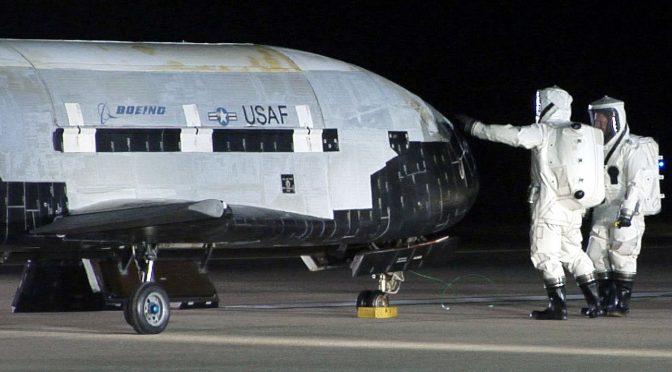By M. Scott Lassiter
The last time Congress created a new military branch was in 1947 when they formed the Air Force out of the Army Air Corps. Now, several Congressmen want to create a new branch of the military: the Space Corps. However, when the House of Representatives passed the final version of this year’s National Defense Authorization Act (NDAA), now signed into law by President Trump, it addressed the controversial proposal in no uncertain terms:
“No funds authorized to be appropriated by this Act or otherwise available for fiscal year 2018 for the Department of Defense may be used to establish a military department or corps separate from or subordinate to the current military departments, including a Space Corps in the Department of the Air Force, or a similar such corps in any other military department.” ~H.R.2810 – National Defense Authorization Act for Fiscal Year 2018, Section 6605
Its proposer and strongest supporter, Representative Mike Rogers (R-AL), asserted that the Air Force has dropped the ball on space over the last two decades, allowing our adversaries to close the space technology gap with us. The only thing that could save us now was to create an entirely new branch of the military– The Space Corps– sharing a similar relationship with the Air Force as the Marine Corps has with the Navy.

To be fair, we do have a problem. Modern Air Force strategy has highly valued fighters and air attack. Accordingly, fighter pilots represent 31 percent of the Air Force General Officer leadership, to include six out of the fourteen top four-star officers (for comparison, Air Force Personnel Command reports pilots of ANY aircraft compose only 20 percent of officers). Officers in other fields (such as space) have historically not been promoted as frequently or highly. Additionally, sixteen years of combat operations under inadequate budgets have encouraged raiding the space funds of tomorrow to meet the mission requirements of today.
Most significantly, our adversaries have indeed enhanced many of their space capabilities to near-peer status. Recently, China tested quantum communication satellites, and Russia enthralled the Space community with maneuvering satellites that have unknown strategic intentions. Both countries, as well as the European Union, have launched their own navigation satellites to remove their reliance on the American GPS constellation.
However, Rep. Roger’s Space Corps plan ignored three important truths:
1. Our adversaries have a vote on what their space capabilities are. Even with more focus on space, on what grounds were we to protest or prevent Russia from launching satellites? They have just as much right to the peaceful use of space as we do, and embarrassingly, we depend on them for all of our own manned space flight since the shuttle retirement in 2011.
2. We already have Air Force Space Command (AFSPC) Headquartered in Colorado Springs, it is run by four-star General John “Jay” Raymond. What would a Space Corps realistically do that AFSPC is not capable of doing? If Congress aims to get him a seat on the Joint Chiefs of Staff, it would be easier to amend Title 10 of the United States Code to make him a required consultant on all issues related to space, or change who he ultimately reports to. There is a precedent: that was the initial role the Commandant of the Marine Corps played before he was given a permanent seat. Such an amendment would also be far easier to implement than forming an entirely new branch.
3. A new military department will only complicate appropriations. Fiscal year 2009 was the last time Congress passed an appropriations bill for the Department of Defense before the actual start of the fiscal year. This has led to numerous continuing resolutions that Army Chief of Staff General Mark Milley called “professional malpractice” when he testified to Congress in April. Approaching a decade of indiscriminate budget cuts from sequestration, our forces are stretched thin. Congress proved this point on January 19th when they failed to pass the third continuing resolution for the 2018 fiscal year. The first two passed only hours before yet another government shutdown. When the third failed, the entire federal government shut down for almost three days until they ended it on January 22, with only another three-week stopgap passed. A new military branch would incur more redundant overhead. What makes Congress think that if we can’t afford to adequately fund space now, or anything else, we can afford it after we spend billions on a whole new branch?

The Space Corps idea received a cold reception from the Department of Defense from the start. Air Force Secretary Heather Wilson told Congress, “If I had more money, I would put it into lethality, not bureaucracy.” Her sentiments were seconded in separate testimonies by General John Hyten, the Commander of United States Strategic Command (USSTRATCOM), as well as General Raymond.
Secretary of Defense James Mattis also opposed it. While he has recognized that we need to update our approach to space, he believes no one has adequately argued that the Space Corps is the way to do it. It would only become another budget strain.
To the Air Force’s credit, they realized several years ago that they were dropping the ball on space. It is no accident that General Raymond, a man with a background in missiles and space, was put in charge of AFSPC. Backing him up as the Unified Combatant Commander over AFPSC, General Hyten also has significant space experience. He led AFSPC as its previous Commander and served as the deputy there before that.
Even though the final NDAA scrapped the Space Corps, Congress did make at least one critical change to benefit AFSPC. General Raymond’s job now comes with a minimum six-year term. This draws from the Naval Reactors model begun by Admiral Hymen G. Rickover, where the Admiral oversees the program for an eight-year term. This has contributed to the Navy’s consistently strong nuclear operational and safety record, and it will do worlds of good for the space program as well.
The Air Force has the right leadership cadre in place. It needs a chance for this reinvigorated command structure to succeed. Proposing the Space Corps did get the attention of all the right people, but it has more problems than solutions. The concept will likely keep reappearing every year for the foreseeable future, as several congressmen have alluded to. Will our military one day require a Space Corps? Possibly. But it is not today, and it is not next year. Killing the proposal now was the right call.
Scott Lassiter is a U.S. naval officer assigned to United States Strategic Command, and a member of the Navy’s Space Cadre.
The opinions expressed in this article do not necessarily represent the views of the United States Navy, Air Force, Strategic Command, or Department of Defense.
Featured image: US Air Force personnel examine the experimental orbital vehicle known as the X-37B after a successful landing at Vandenberg AFB in December 2010. (AP)

